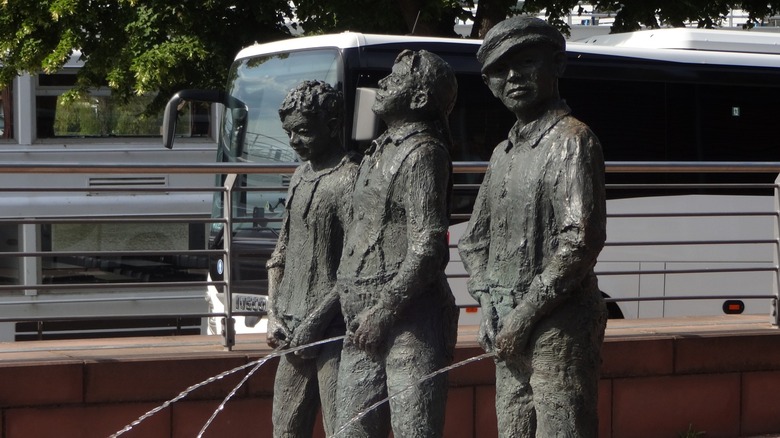A Historic Town With Hidden Corners And Romantic Alleyways Holds Bavaria's Oldest Inn
Located on the border between Bavaria and Hessen, about 45 miles from both Frankfurt and Heidelberg, the charming half-timbered wooden lattice buildings of Miltenberg would be enough to fool anyone into thinking this historic beauty is Germany's oldest city. But instead, the town of less than 10,000 on the Main River has another claim to fame: It is home to the oldest royal inn in Germany, a traditional country food hall that's known today as Zum Riesen, or "The Giant." From the 12th century, a farm stood on the site; and in 1314, Ludwig, King of Bavaria, was said to have stopped in, staying for eight days. The building that's there today, constructed in 1590 — presumably with some parts of the original — looks much like it did back then.
You can reach Zum Riesen on Hauptstraße 99 in Miltenberg, where the restaurant serves lunch and dinner seven days a week. Its very traditional German menu features all of the greatest hits of the country's cuisine, from bratwurst and schnitzel to pretzels and kaesespaetzle, the German version of mac and cheese. The kitchen closes in the afternoon between 3 p.m. and 4:30 p.m., when you'll have to make due with a few of 17 beers brewed by the local brewery, Brauhaus Faust, that are served on tap.
The central town is a preserved medieval gem
The city's central square, Marktplatz, is home to more of those adorable 16th century, half-timbered buildings in brightly-painted colors that inspire the fairytale-like German magic of old Disney films. The entire neighborhood, Schwarzviertel, is the town's oldest and includes the oldest building in town, dating from 1339. The City Museum, on Hauptstraße 169-175, is housed in a similarly quaint building with an art collection and Renaissance garden. It's closed from January 15 to March 15, with short daily opening times through the rest of the year. Miltenberg's old town hall on Hauptstraße 137, which dates from 1379, serves as a meeting place and dancehall now, making it a great place to stop in and see what's happening during your visit.
A sandstone fountain in the middle of the square leads visitors directly up a footpath that climbs a hill into the forest. At the top of the footpath, you'll run into the Schnatterloch, a tower along the city wall with a hole in it that allowed for drainage from the hillside to the Main River at the edge of the town. Continue to the top of the hill to see the Miltenberg Castle Museum on Conradyweg 20. It's another small art museum in a fantastic historic setting, with views overlooking the entire town. You'll find this museum open from March 16 until November 1 from 10 a.m. until 4 p.m. on Tuesdays through Sundays.
More unusual surprises are around every corner
Like every quaint German town with old medieval streets, you are sure to find some odd landmarks in Miltenberg too. A favorite statue in the city on Mainstrasse features three working-class characters peeing (don't worry, it's just water) into the fountain. Of course, there's more to the story, which includes history, slang, and even a pun: The statue's subjects come from the nickname for residents, "Staffelbrunsers," which refers to the people who fetched water from the Staffelbrunnen (the city's historic water well) in the early days. The word "brunnen" (well) was swapped with "brunsen," regional slang meaning "to urinate," and the image of the urinating townsfolk was born — hence the name of the statue and fountain, the "Staffelbrunserbrunnen."
Finally, Miltenberg is home to 44 Stolpersteine, the German "tripping stones" that commemorate Germans who died or were displaced by the fascist Nazi government. The shiny gold stones stand in place of cobblestones in front of the homes where interred and murdered Jews, communists, and resistance fighters once lived, reminding residents and visitors of a past the Germans never want to forget or relive. You can leave a flower or memorial gift in front of a Stolperstone at any time of year.


